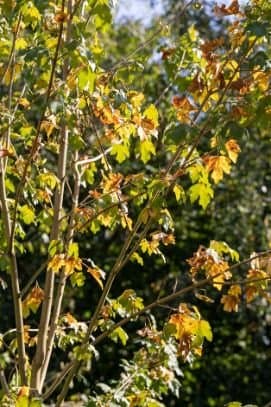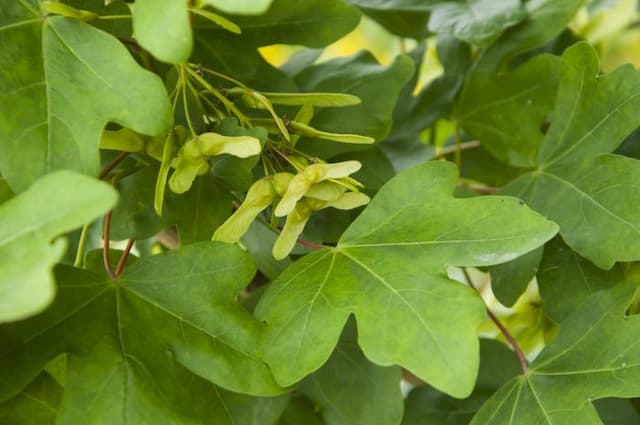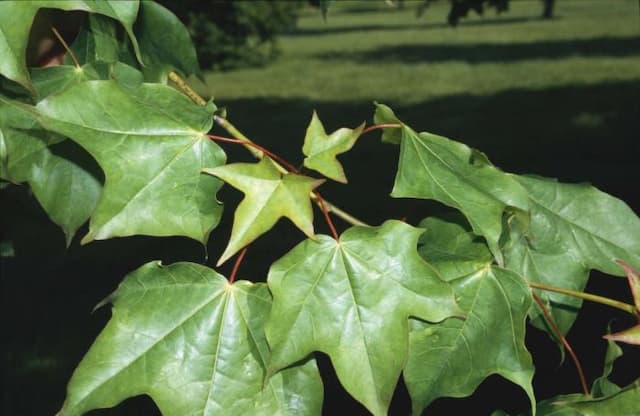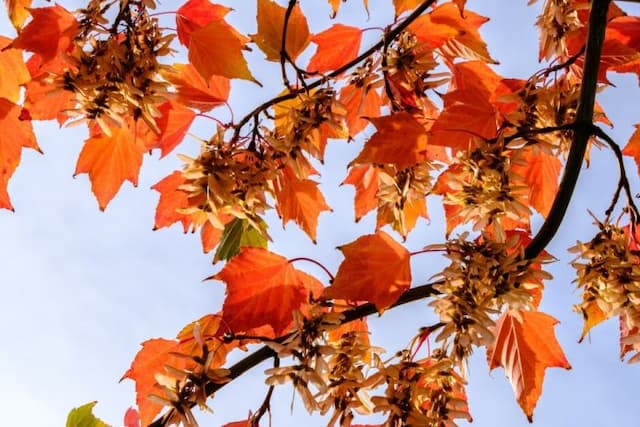Norway Maple Acer platanoides 'Meyering'

ABOUT
Acer platanoides 'Meyering', commonly known as the Norway maple, is a cultivar that showcases a range of distinctive features. The leaves are the plant's most notable characteristic, bearing a deep green color and a classic maple shape with pointed lobes that radiate out from the center, resembling a hand with outstretched fingers. These leaves can sometimes display a hint of red or purple when they first emerge, adding a splash of color to the early spring landscape. During the blooming period, this Norway maple presents clusters of small, attractive flowers. The flowers are often a subtle yellow-green hue, which contrasts nicely against the fresh foliage, attracting pollinators to the plant. Following the flowering season, the tree develops samaras, which are winged seed pods that helicopter to the ground when ripe, helping to disperse the seeds. The bark of the Norway maple 'Meyering' typically has a grayish-brown color, providing a neutral backdrop that highlights the vibrant leaves and flowers. It is fairly smooth in the tree's youth and becomes more textured with age, developing furrows and ridges that give the tree character as it matures. The overall shape of the Norway maple is balanced and symmetrical, with a rounded crown that provides ample shade. Its branches grow outward in a relatively uniform fashion, contributing to the dense, leafy dome that is characteristic of this plant. With its classic maple silhouette, this Norway maple cultivar is a valuable addition to any landscape, chosen for its visual appeal across the seasons.
About this plant
 Names
NamesFamily
Sapindaceae.
Synonyms
Norway Maple.
Common names
Acer platanoides 'Meyering'.
 Toxicity
ToxicityTo humans
The Acer platanoides 'Meyering', commonly known as the Norway maple, is not generally recognized as a poisonous plant to humans. However, like many trees, the sap or other parts may cause irritation in some individuals with sensitive skin. Ingesting parts of the plant is not commonly associated with poisoning in humans, so there is little documented evidence of symptoms or consequences from ingestion. Still, it's advisable not to eat parts of ornamental plants due to potential individual reactions or non-toxicity related health issues such as choking hazards.
To pets
The Norway maple is not generally known to be toxic to pets. There is limited information on the toxicity of Acer platanoides 'Meyering' to animals like cats and dogs, as it is not commonly reported to cause significant symptoms of poisoning in pets. As with humans, it's still best to prevent pets from ingesting plant material as it may cause gastrointestinal upset or other non-toxic related issues such as blockages, especially if large quantities of non-digestible material are consumed.
 Characteristics
CharacteristicsLife cycle
Perennials
Foliage type
Deciduous
Color of leaves
Green
Flower color
Yellow
Height
50 feet (15.24 meters)
Spread
35 feet (10.67 meters)
Plant type
Tree
Hardiness zones
4
Native area
Europe
Benefits
 General Benefits
General Benefits- Shade Provider: Norway maple 'Meyeri' offers a broad canopy for shade in gardens and streets.
- Aesthetic Appeal: With its attractive foliage and form, it enhances the visual interest of landscapes.
- Seasonal Color: Its leaves turn a vibrant yellow or orange in the fall, providing seasonal color.
- Wildlife Habitat: It offers shelter and sometimes food for birds and small mammals.
- Tolerance to Conditions: Resistant to pollution and soil compaction, it is suitable for urban environments.
- Windbreak: The tree acts as a windbreak, protecting smaller plants and reducing wind speed in its vicinity.
- Erosion Control: Its roots help to stabilize the soil and prevent erosion.
 Medical Properties
Medical PropertiesThis plant is not used for medical purposes.
 Air-purifying Qualities
Air-purifying QualitiesThis plant is not specifically known for air purifying qualities.
 Other Uses
Other Uses- Acer platanoides 'Meyering', commonly known as Norway Maple, can be used for woodworking and cabinetry due to its fine texture and workability.
- The wood of Norway Maple is also used for making musical instruments, such as violins and guitars, for its acoustic properties.
- Its sap can be used as a substitute for maple syrup, though it is not as sweet as the syrup from its relative, the Sugar Maple.
- Norway Maple leaves are sometimes used in composting as they break down relatively quickly and add nutrients back into the soil.
- In landscape photography, the vivid autumn colors of the Norway Maple can be used as a stunning natural backdrop.
- The tree's dense canopy can provide a natural sound barrier, making it useful for planting along busy streets or highways to reduce noise pollution.
- During autumn, the dry, fallen leaves of the Norway Maple can be used as mulch to insulate plants and protect them from cold weather.
- Woodturners may use the wood from the Norway Maple to create decorative bowls, plates, and other turned objects.
- Since the Norway Maple has a dense crown, it can be used in urban areas to provide shade and reduce the heat island effect.
- The dried seeds, or samaras, of the Norway Maple can be used in arts and crafts projects for children and adults alike due to their unique winged shape.
Interesting Facts
 Feng Shui
Feng ShuiThe Norway Maple is not used in Feng Shui practice.
 Zodiac Sign Compitability
Zodiac Sign CompitabilityThe Norway Maple is not used in astrology practice.
 Plant Symbolism
Plant Symbolism- Strength: The Acer platanoides, commonly known as the Norway Maple, is known for its hardy and robust nature, symbolizing inner strength and resilience.
- Longevity: With its potential to live for many decades, the Norway Maple represents long life and endurance.
- Independence: The tree's ability to thrive in a variety of conditions signifies autonomy and self-sufficiency.
- Beauty: With its attractive foliage that changes colors with seasons, the Norway Maple symbolizes natural beauty and the cyclical nature of life.
- Balance: The symmetrical shape of the maple leaf is often seen as a symbol of balance and proportion in one's life.
- Generosity: The shade and shelter provided by the Norway Maple are seen as symbols of generosity and protection.
- Wisdom: In some cultures, the tree is associated with wisdom due to its long lifespan and the observing nature of its towering presence.
 Water
WaterThe Norway Maple requires watering deeply about once or twice a week during the growing season, depending on the climate and soil conditions. It's crucial to avoid shallow watering; instead, aim to provide enough water to moisten the soil to a depth of at least 6 inches, which could equate to about 20-25 gallons for a mature tree depending on size and environmental factors. During dry spells or hot weather, water requirements may increase. Reduce watering frequency to once every two to three weeks in the fall, and during the winter, natural precipitation will generally suffice unless there are extended dry periods.
 Light
LightThe Norway Maple prefers full sunlight to partial shade. The optimal spot for this tree is a location where it can receive at least six hours of direct sunlight daily. While it can tolerate some light shade, growth and foliage density might be reduced in shadier spots.
 Temperature
TemperatureThe Norway Maple is a hardy tree and can tolerate a wide range of temperatures. It can survive minimum temperatures down to around -30 degrees Fahrenheit and is comfortable in the typical temperature range experienced by the regions where it grows best. The ideal temperature conditions for this tree are between 50 and 80 degrees Fahrenheit, where it can thrive and grow optimally.
 Pruning
PruningThe Norway Maple should be pruned to remove dead or diseased branches, to improve the tree's shape, and to remove any branches that could pose a hazard. Pruning is best done in late winter or early spring before the sap starts to flow. It is not necessary to prune this tree annually, but periodic inspection and corrective pruning every 3 to 5 years can help maintain its health and appearance.
 Cleaning
CleaningAs needed
 Soil
SoilNorway Maple 'Meyering' thrives in well-draining, fertile loam with a pH of 5.5 to 7.5. A mix of garden soil, compost, and perlite or sand is ideal to ensure adequate drainage and fertility.
 Repotting
RepottingNorway Maples in containers should be repotted every 3-5 years to prevent root bounding and to replenish nutrients in the soil.
 Humidity & Misting
Humidity & MistingNorway Maple 'Meyering' is tolerant of average outdoor humidity levels and does not require specific humidity conditions when planted in the landscape.
 Suitable locations
Suitable locationsIndoor
Not suitable for indoor growing due to size.
Outdoor
Plant in well-draining soil, full sun to partial shade.
Hardiness zone
4-7 USDA
 Life cycle
Life cycleAcer platanoides 'Meyering', commonly known as the Norway Maple 'Meyering', begins its life as a seed that germinates in spring after experiencing a cold stratification period over winter. The germinated seedling then grows into a young sapling, which establishes its root system and begins to produce leaves through photosynthesis. Over several years, the sapling matures into an adult tree, developing a sturdy trunk and branching structure, and once mature enough, it starts to flower in spring. Following pollination, typically by insects, the flowers develop into winged samaras (helicopter seeds) that disperse in the wind, allowing for propagation of the species. The Norway Maple 'Meyering' can live many decades, during which it will experience periodic growth in height and canopy spread, along with yearly cycles of leafing out in spring, photosynthesizing in summer, and going dormant in fall, shedding its leaves before winter. The tree eventually reaches senescence, characterized by decreased vigor and productivity, before ultimately dying, completing the life cycle.
 Propogation
PropogationPropogation time
Spring-Early Summer
Propogation: The Norway Maple 'Meyeri', a cultivar of Acer platanoides, can be propagated most effectively through grafting, especially during the dormant season which typically falls in late winter to early spring. In this method, a stem from the 'Meyeri' variety with at least one bud is joined to a rootstock of another maple variety. The grafting site is prepared by making a diagonal cut on the rootstock and a corresponding cut on the scion, ensuring that the cambium layers of both parts contact each other. These two pieces are then bound together with grafting tape and sealed with grafting wax to prevent desiccation and protect the union from pathogens. This graft must then be placed in a moist environment maintaining a temperature between 70°F to 80°F (21°C to 27°C) to encourage successful joining and growth. After the graft has taken and new growth is evident, the tree can be gradually acclimatized to outdoor conditions before planting out.









